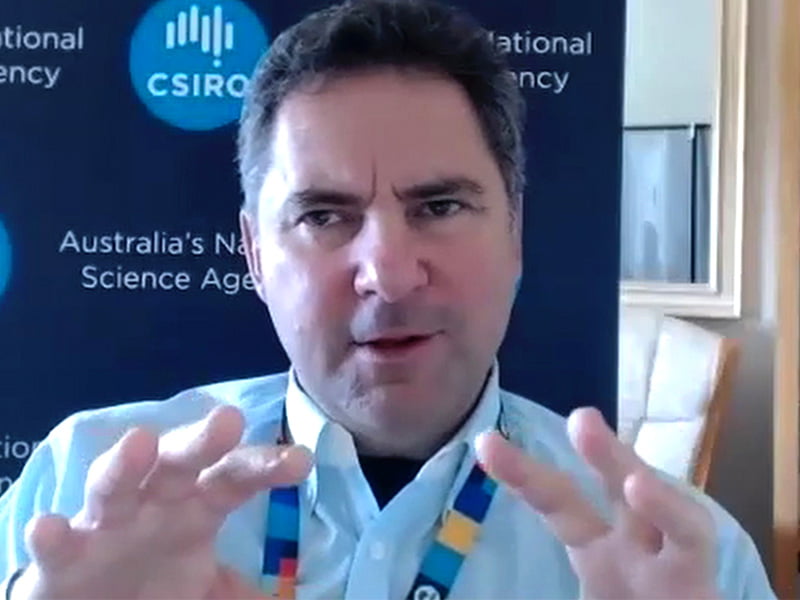The national science agency has released a once-in-a-decade report that identifies seven global megatrends that will shape the challenges and significant opportunities Australia will face in the coming years.
The CSIRO’s Our Future World report makes for difficult reading across challenges ranging from climate change to food production and biologicals, and explores the geopolitical, economic, social and technological forces that are likely to have an impact on Australia.
CSIRO chief executive Larry Marshall, who will address the National Press Club in Canberra on Wednesday, says the report will help Australians to understand the significant challenges in order to address the massive opportunities that will shape the world.

The seven global megatrends are: Adapting to climate change; Leaner, cleaner and greener; The escalating health imperative; Geopolitical shifts; Diving into digital; Increasingly autonomous; and Unlocking the human dimension.
“Australia is at a pivotal point. There is a tidal wave of disruption on the way, and it’s critical we take steps now to get ahead of it,” Dr Marshall said.
“From resource scarcity to drug resistant superbugs, disrupted global trade, and an increasingly unstable climate threatening our health and way of life – these are just some of the challenges we face.
“But these challenges also tell us where the most powerful innovation can be found, when we see a different future and leverage science to create it,” he said.
The report outlines a “next wave” of digital innovation, fuelled by artificial intelligence, that will generate $10 trillion to $15 trillion globally
The adoption of high-performance computing, AI, machine learning, sensors and IoT, robotics and other Industry 4.0 technologies are growing rapidly across the world, the report says, identifying currently available technologies that could contribute $140 billion to $250 billion to Australia’s GDP by 2025.
The challenge for Australia is that its digital technology sector is less developed than comparable countries. Compared to other advanced economies, Australia has captured less value from digital innovation (11.2 per cent versus 7.4 per cent of GDP respectively), particularly in regards to developing new digital industries.
There are untapped opportunities for Australia to accelerate digital adoption and its associated productivity gains.
“The next wave of digital innovation will generate $10–15 trillion globally,” Dr Marshall said.
“Australia can tap into this to transform existing jobs and create new jobs and wealth while leveraging Artificial Intelligence to solve some of our greatest challenges, like outthinking bushfires, accelerating vaccine development, predicting drought, or stabilising our energy grid.”
“We have the opportunity now to use science to invent the kind of world we want to live in – but we have to act, and we have to do it together,” Dr Marshall said.
The seven megatrends:
- Adapting to climate change: with natural disasters expected to cost the Australian economy almost three times more in 2050 than in 2017, we can expect to be living in a more volatile climate, characterised by unprecedented weather events.
- Leaner, cleaner and greener: an increased focus on potential solutions to our resource constraints through synthetic biology, alternative proteins, advanced recycling and the net-zero energy transition. By 2025, renewables are expected to surpass coal as the primary energy source.
- The escalating health imperative: the post-pandemic world has exacerbated existing health challenges posed by an ageing population and growing burden of chronic disease. One in five Australians report high or very high levels of psychological distress and there is heightened risk of infectious diseases and pathogens resistant to modern antibiotics. There is now a burning platform to also respond to our health risks and improve health outcomes.
- Geopolitical shifts: an uncertain future, characterised by disrupted patterns of global trade, geopolitical tensions and growing investment in defence. While the global economy shrunk by 3.2 per cent in 2020, global military spend reached an all-time high of $2.9 trillion and Australia saw a 13 per cent increase in cybercrime reported relative to the previous year.
- Diving into digital: the pandemic-fuelled a boom in digitisation, with teleworking, telehealth, online shopping and digital currencies becoming mainstream. Forty percent of Australians now work remotely on a regular basis and the future demand for digital workers expected to increase by 79 per cent from 2020 to 2025.
- Increasing autonomous: there has been an explosion in artificial intelligence (AI) discoveries and applications across practically all industry sectors over the past several years. Within the science domain the use of AI is rising with the number of peer-reviewed AI publications increasing nearly 12 times from 2000 to 2019.
- Unlocking the human dimension: a strong consumer and citizen push for decision makers to consider trust, transparency, fairness and environmental and social governance. While Australia saw a record level increase in public trust in institutions during the pandemic, this ‘trust bubble’ has since burst, with societal trust in business dropping by 7.9% and trust in government declining by 14.8 per cent from 2020-21.
Do you know more? Contact James Riley via Email.


Good to see this report referenced and available here…
HW